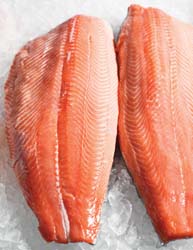 Wild Caught Fish
Wild Caught Fish
I buy wild caught fish, not farmed nor genetically modified.
By Jan Walsh
Photography by Beau GustafsonI have enjoyed fresh caught fish and seafood since I was a child. I can recall my “Daddy Joe” taking me on my first fishing adventure to Highland Lake, near Oneonta. I threw my line from the bank straight into the limbs of a tree hanging over the water. I was not concerned about the line but was worried that the worm was afraid being up so high, given his home was in the earth. I have fished a couple of times since that time—before deciding to leave fishing to the pros.
Today I order fish and seafood at restaurants where I trust their sources. At Birmingham’s best restaurants I often see the fishermen listed on the menu, such as “Greg Abrams.” If salmon is on the menu I look for “wild caught” or better yet look for where it was caught. If the menu does not state if salmon is farmed or wild, then I ask. If the server does not know, I have them ask the kitchen. If the kitchen does not know, I don’t order it.
Wild fish get their omega-3’s from aquatic plants and thus have high nutritional value. Many farmed fish are fed GMO soy, corn, and other foods that contain little or no omega-3s. Corn fed fish develop the undesirable type of fatty acids. And these fish are routinely given antibiotics. Much like cattle dosed with antibiotics, this can contribute to antibiotic resistant disease in the people who eat them. Other farmed fish that can’t survive on soy and corn are fed smaller fish, which is leading to overfishing of small species of fish, such as anchovies and herring. The fish also stress due to the confinement and develop diseases and parasites. Farmed fish try to escape these unnatural living conditions and migrate off the farm, infecting the wild fish population and breeding with it, thus harming the wild population and compromising the gene pool as well as allowing for confusion between what is true “wild caught” fish and hybrids created from cross breeding.
Thus mislabeling of farmed fish is a real concern. A recent report by the Oceana found that of eighty-two salmon samples taken from restaurants and grocery stores, forty-three per cent were mislabeled. Sixty-nine percent of the mislabeling involved farmed Atlantic salmon being sold as wild caught Pacific salmon.
Approximately two-thirds of the salmon consumed by Americans is farmed in other countries. And seventy percent of U.S. caught wild salmon is exported abroad to Europe and Japan, and some of this fish is exporting for processing, due to higher processing costs here. Much of this U.S. wild salmon catch is gutted in Alaska, then frozen and shipped to China where the fish are thawed, filleted, stripped of the pin bones, refrozen, and re-imported to the U.S.
And in 2016 a new salmon will appear in the U.S. For the first time in history a engineered animal has been approved for human consumption. AquaBounty AquAdvantage, (GMO salmon) a genetically engineered species of fish, will go into commercial production. The fish was approved by the USDA in 2015. The new fish’s genetic code is comprised of components from three fish: its base DNA from an Atlantic salmon, growth gene from Pacific Chinook salmon; and promoter from a knobby-headed eel-shaped creature called an ocean pout. Many restaurants and grocers are refusing to sell the GMO fish.
When buying seafood to cook at home, I never buy farmed fish or GMO fish. I want not only the freshest seafood, but also want to know where it came from and when it was caught. So I shop at Sexton's Seafood, which has been a family owned and operated by the Schroeder family for three decades. Sexton’s supplies Birmingham with the fresh and pure Gulf seafood arriving here in their own trucks and other fish mongers trucks several times weekly. They also offer tips and expertise on how to cook it. Sexton’s Birmingham market is located at 3164 Cahaba Heights Road in Cabaha Heights. And Sexton’s has a location in Destin, Florida.
Published, B-Metro magazine, January 2016